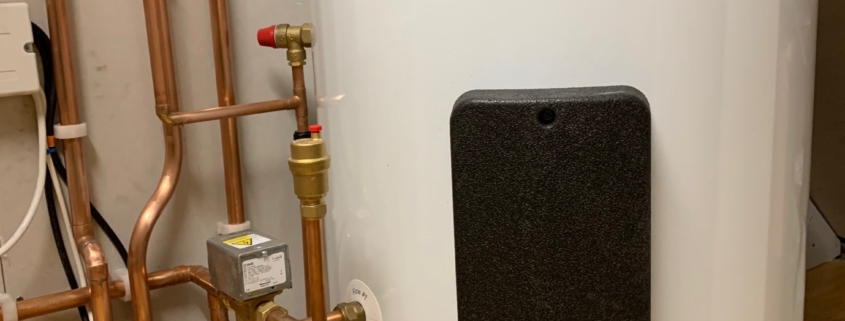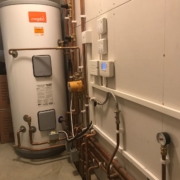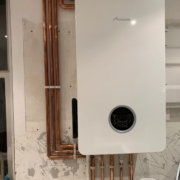Can I put an Unvented Cylinder in the Loft? A Case Study
Can I put an Unvented Cylinder in the Loft? Before we start, it is important to point out that all Cloverleaf engineers are fully qualified to work on and install unvented hot water systems.
The G3 qualification proves competence and allows us to register the cylinder with building control on completion of the job. We can also raise a building regs compliance certificate. When you come to sell the house, this is worth its weight in gold. It’s proof that you have employed a competent person to do the job and that it has been signed off with building control.
Let’s say you have decided, hopefully with our help, to opt for an unvented cylinder over a combi boiler. There are many installation considerations which I will highlight in this post. We’ll not go into detail about why you should or shouldn’t have an unvented cylinder, but discuss if it’s ok to put one in your loft space.
One of the downsides of an unvented cylinder is that it still takes up valuable space! So one of our most popular conversions from a low pressure system to a high pressure system is to hide the cylinder in the loft. But what are the perils of putting 200L litres of hot water under pressure above your head? And how do you do it safely?
Consideration 1 – Weight and height
Water is heavy! 1 litre of water weighs 1 kilo so a 200 litre cylinder of water can easily weigh 250kg when full up. That’s a quarter of a tonne!
The first thing we check when surveying is if there’s a supporting wall directly underneath the proposed cylinder location. This is very important because this amount of weight can actually bow ceiling joists if the weight is not supported adequately.
If we are taking a cold water tank out, it is very likely the tank has already been sited with a supporting wall below. But we never take this for granted.
Once you find yourself a nice supporting wall, we are then looking for decent head height so the cylinder can stand up. This can sometimes have an impact on the size of cylinder you end up with. There are cylinders available now that lay on their side, so this is a problem we can usually work around.
Consideration 2 – How big?
I think all plumbers have done this once in their lives. Turned up to a job with a cylinder that’s perfect for the customer’s needs. But it doesn’t fit through the loft hatch! Cylinders do come in all shapes and sizes. Getting it through that small, square hole has to be high on the list of things to check first. And definitely before committing to a cylinder in the loft.
Again this is something we would check at the survey stage. Loft hatches can be made bigger at very little expense, so don’t write the idea off until we’ve checked it.
Consideration 3 – Frost
When all your hot water is sitting above your heads, it is well worth mentioning the dreaded burst pipe.
If all your pipework in the loft has soldered fittings and is fully lagged, there really shouldn’t be anything to worry about. Unfortunately, so often this is not what we find when we pop our heads into customers’ lofts. On our travels we see some absolutely horrific plumbing. And usually the catalyst to a new water feature in your bedroom is very cold weather.
On the survey, we look for how well the roof is insulated and how easily outside temperatures would penetrate the loft space.
The cylinder is already well insulated so it comes down to the thickness of the pipe insulations. We also aim to remove plastic push fit fittings anywhere on the installation. This dramatically reduces the risk of anything leaking in the event of sub-zero temperatures.
Consideration 4- Discharge Pipe
What happens when you heat water under pressure? It wants to expand and escape. This is the primary reason why unvented cylinders are built a lot stronger than conventional cylinders.
Unvented cylinder regulation is very tight in this country. There are many safety devices fitted as part of a correct install to prevent the cylinder from ever getting into an explosive state.
The downside of all this safety is that a discharge pipe has to travel from the cylinder to a safe termination point at low level. This does sometimes put people off having an unvented cylinder. The pipe needs to be at least 22mm and made of copper. Not always a pretty sight.
We have done some clever installs though. We have run the pipe internally and drilled it out of the wall at the last minute. This avoids any pipe showing on the outside. But in the majority of cases, there will probably will be a copper pipe coming down the wall somewhere. Best I prepare you for it now! This is again something that is considered at the survey stage.
The regulations do say we are allowed to terminate the discharge pipe into a waste pipe. We would only do this as a last resort if there is no feasible route for the copper discharge to travel to a low level point outside.
And that is all I have to say on the matter for now.
I hope that my comments have been useful. If you are thinking about unvented hot water in any shape or form, please use the contact form and we’ll get back to you.
I would be very happy to discuss your requirements over Zoom or FaceTime until we are out of this lockdown situation.









